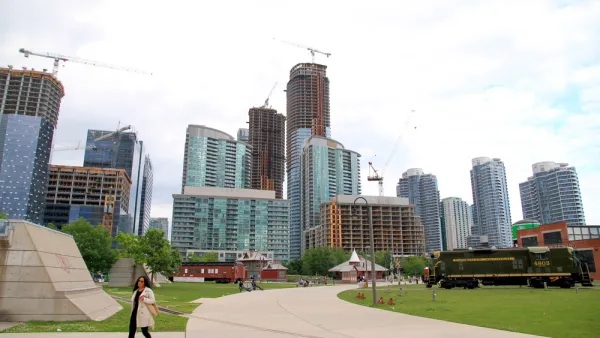Since it began in 1999, Toronto's condo boom has added 120,000 units to the city and, in the process, transformed its urban landscape. City leaders are just now beginning to address how to accommodate these new residents.
"In the last decade, the condo boom in Toronto has stacked the skyline with towers. Now, the approximately 250,000 to 275,000 people who live in them say that, in the race to build, city planners and councillors failed to adequately consider how to create neighbourhoods," reports Dave McGinn. "But the city is finally starting to listen."
“'I don’t think we anticipated, say, five years ago, or even before that, that this boom was going to continue,' says Peter Moore, project manager for the City of Toronto. Last month, the city launched the first of its kind series of public consultations to improve conditions for condo dwellers. The initiative is an acknowledgment that Toronto’s condo culture is here to stay." From poor condo construction to inadequate green space, participants' concerns extended from inside their units to the larger neighborhood.
“We need to be thinking much more extensively about … condos not as buildings but as part of a neighbourhood,” says Jennifer Keesmaat, the city’s chief planner. “We’re seeing a significant transition in the landscape and the form of the city at this moment that really is the impetus for us beginning to think in new ways about how neighbourhoods are defined in the city.”
FULL STORY: How can Toronto blend condos and community?

National Parks Layoffs Will Cause Communities to Lose Billions
Thousands of essential park workers were laid off this week, just before the busy spring break season.

Retro-silient?: America’s First “Eco-burb,” The Woodlands Turns 50
A master-planned community north of Houston offers lessons on green infrastructure and resilient design, but falls short of its founder’s lofty affordability and walkability goals.

Delivering for America Plan Will Downgrade Mail Service in at Least 49.5 Percent of Zip Codes
Republican and Democrat lawmakers criticize the plan for its disproportionate negative impact on rural communities.

Test News Post 1
This is a summary

Test News Headline 46
Test for the image on the front page.

Balancing Bombs and Butterflies: How the National Guard Protects a Rare Species
The National Guard at Fort Indiantown Gap uses GIS technology and land management strategies to balance military training with conservation efforts, ensuring the survival of the rare eastern regal fritillary butterfly.
Urban Design for Planners 1: Software Tools
This six-course series explores essential urban design concepts using open source software and equips planners with the tools they need to participate fully in the urban design process.
Planning for Universal Design
Learn the tools for implementing Universal Design in planning regulations.
EMC Planning Group, Inc.
Planetizen
Planetizen
Mpact (formerly Rail~Volution)
Great Falls Development Authority, Inc.
HUDs Office of Policy Development and Research
NYU Wagner Graduate School of Public Service



























